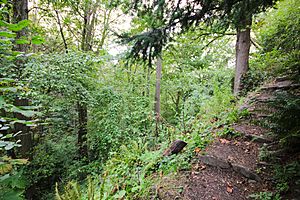St. Mark's Greenbelt facts for kids
The St. Marks Green Belt is a special natural area in Seattle, Washington. It's like a long, narrow park that helps keep the city green. This greenbelt is a quiet space that helps block out some of the noise from the busy I-5 highway, especially for people living in the Capitol Hill area. You can find a walking trail here that starts and ends near the Lefler House parking lot. A small creek also flows through the western part of the greenbelt, sometimes above ground and sometimes through pipes.
Contents
Exploring the Green Belt's Location
The St. Marks Green Belt is located in Seattle. It has clear boundaries on its west and east sides. To the west, you'll find East Blaine Street, and to the east, it's bordered by 10th Avenue East. The northern and southern edges are a bit less clear, blending in with trees and nearby houses.
History of the St. Marks Green Belt
How the Green Belt Became Protected
In 1993, the city of Seattle decided to protect the St. Marks Green Belt. It became part of a plan to save important green spaces around the city. This decision helped make sure the area would stay natural for everyone to enjoy.
Adding Gardens and Trails
Later in the 1990s, a family named Streissguth generously gave more land to the greenbelt. This new land included a beautiful, lasting garden known as the Streissguth Gardens. In 2007, a big grant (which is like a gift of money) was given by the city. This money went to two groups: Green Seattle and St. Mark's Episcopal Cathedral. They used the funds to remove harmful plants that didn't belong there and to build new walking trails for visitors.
Plants and Animals of the Green Belt
Understanding Plants in the Green Belt
Over the last ten years, the St. Marks Green Belt has faced a challenge. It has been taken over by "invasive species" of plants. These are plants that are not native to the area and can harm the local ecosystem. The main problem plants here are Holly and Ivy. Because there aren't many native plants, especially evergreen trees like conifers, there isn't much food or shelter for city wildlife.
Wildlife You Might See
Even with the plant challenges, the greenbelt is a safe place for some animals. It's especially important for raptors, which are birds of prey like hawks and falcons. These birds often hunt near I-5. If you visit, you might be lucky enough to see American Kestrels. Sometimes, you might even spot a Peregrine Falcon, which is one of the fastest birds in the world!


